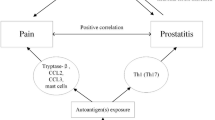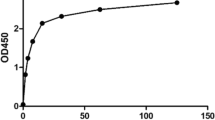Abstract
The exact etiology and pathogenesis of chronic prostatitis/chronic pelvic pain syndrome (CP/CPPS) are still unknown, as a result, available therapeutic options for patients are far from satisfactory. Therefore, there is a need to develop a valid therapeutic approach that can ameliorate the manifestations of CP/CPPS. Fifty male C57BL/6 mice were randomly divided into five groups of ten mice each. All groups except naïve were subcutaneously injected with 0.2 ml of T2 plus complete Freund adjuvant (CFA) on day 0 and 14 to generate valid CP/CPPS model. After successful CP/CPPS induction, model group was injected with 0.2 ml of normal saline while PLGA, PLGA-OVA, and PLGA-T2 groups were administered intravenously with 0.2 ml mixture of PLGA, PLGA-OVA, and PLGA-T2, respectively. Voiding behavior, pain threshold, and hematoxylin and eosin staining were used to assess micturition habits, pain intensity as well as prostate inflammation. Additionally, TNF-α, CRP, and IL-10 levels in plasma were measured by using ELISA kits. Mice administered with PLGA-T2 showed higher pain threshold, lower urine frequencies, mild edema, and inflammation in prostate tissue in comparison to other groups. Moreover, the expression of TNF-α and CRP levels was markedly decreased while IL-10 expression was increased in the PLGA-T2 treatment group as compared to the other groups. Our results showed that nanoparticles conjugated with autoantigen novel peptide T2 could successfully alleviate or even heal CP/CPPS to some extent in mice. This study provides an easy, useful, and economic tool for ameliorating the manifestations of CP/CPPS that will improve the therapeutic approaches.





Similar content being viewed by others
References
Krieger, J.N., D.E. Riley, P.Y. Cheah, M.L. Liong, and K.H. Yuen. 2003. Epidemiology of prostatitis: new evidence for a world-wide problem. World Journal of Urology 21 (2): 70–74.
Nickel, J.C., J. Downey, D. Hunter, and J. Clark. 2001. Prevalence of prostatitis-like symptoms in a population based study using the National Institutes of Health chronic prostatitis symptom index. The Journal of Urology 165 (3): 165(3):842–5.
Khan, F.U., A.U. Ihsan, H.U. Khan, R. Jana, J. Wazir, P. Khongorzul, M. Waqar, and X. Zhou. 2017. Comprehensive overview of prostatitis. Biomedicine & Pharmacotherapy 94: 1064–1076.
Vasdev N and Thorpe AC. Chronic prostatitis / chronic pelvic pain syndrome. Clinical Management of Complicated Urinary Tract Infection. 2011.
Wagenlehner, F.M.E., J.W.O. van Till, V. Magri, G. Perletti, J.G.A. Houbiers, W. Weidner, and J.C. Nickel. 2013. National Institutes of Health Chronic Prostatitis Symptom Index (NIH-CPSI) symptom evaluation in multinational cohorts of patients with chronic prostatitis/chronic pelvic pain syndrome. European Urology 63 (5): 953–959.
McNaughton Collins, M., M.A. Pontari, and M.P. O'Leary. 2001. Quality of life is impaired in men with chronic prostatitis: the Chronic Prostatitis Collaborative Research Network. Journal of General Internal Medicine 16 (10): 656–662.
Wenninger, K., J.R. Heiman, I. Rothman, J.P. Berghuis, and R.E. Berger. 1996. Sickness impact of chronic nonbacterial prostatitis and its correlates. The Journal of Urology 155 (3): 965–968.
Yang, C.C., et al. 2003. Pain sensitization in male chronic pelvic pain syndrome: why are symptoms so difficult to treat? The Journal of Urology 170 (3): 823–826 discussion 826-7.
Polackwich, A.S., and D.A. Shoskes. 2016. Chronic prostatitis/chronic pelvic pain syndrome: a review of evaluation and therapy. Prostate Cancer and Prostatic Diseases 19 (2): 132–138.
Rees, J., M. Abrahams, A. Doble, A. Cooper, and the Prostatitis Expert Reference Group (PERG). 2015. Diagnosis and treatment of chronic bacterial prostatitis and chronic prostatitis/chronic pelvic pain syndrome: a consensus guideline. BJU International 116 (4): 509–525.
Herati, A.S., and R.M. Moldwin. 2013. Alternative therapies in the management of chronic prostatitis/chronic pelvic pain syndrome. World Journal of Urology 31 (4): 761–766.
Breser, M.L., F.C. Salazar, V.E. Rivero, and R.D. Motrich. 2017. Immunological mechanisms underlying chronic pelvic pain and prostate inflammation in chronic pelvic pain syndrome. Frontiers in Immunology 8: 898.
Alexander, R.B., F. Brady, and S. Ponniah. 1997. Autoimmune prostatitis: evidence of T cell reactivity with normal prostatic proteins. Urology 50 (6): 893–899.
Rivero, V. 2002. Prostatein or steroid binding protein (PSBP) induces experimental autoimmune prostatitis (EAP) in NOD mice. Clinical Immunology 105 (2): 176–184.
Penna, G., S. Amuchastegui, C. Cossetti, F. Aquilano, R. Mariani, N. Giarratana, E. de Carli, B. Fibbi, and L. Adorini. 2007. Spontaneous and prostatic steroid binding protein peptide-induced autoimmune prostatitis in the nonobese diabetic mouse. The Journal of Immunology 179 (3): 1559–1567.
Keetch, D.W., P. Humphrey, and T.L. Ratliff. 1994. Development of a mouse model for nonbacterial prostatitis. The Journal of Urology 152 (1): 247–250.
Smith, D.M., J.K. Simon, and J.R. Baker Jr. 2013. Applications of nanotechnology for immunology. Nature Reviews. Immunology 13 (8): 592–605.
Miller, S.D., D.M. Turley, and J.R. Podojil. 2007. Antigen-specific tolerance strategies for the prevention and treatment of autoimmune disease. Nature Reviews. Immunology 7 (9): 665–677.
Luo, X., K.C. Herold, and S.D. Miller. 2010. Immunotherapy of type 1 diabetes: where are we and where should we be going? Immunity 32 (4): 488–499.
Khan, F.U., A.U. Ihsan, W. Nawaz, M.Z. Khan, M. Yang, G. Wang, X. Liao, L. Han, and X. Zhou. 2017. A novel mouse model of chronic prostatitis/chronic pelvic pain syndrome induced by immunization of special peptide fragment with aluminum hydroxide adjuvant. Immunology Letters 187: 61–67.
Zhang, L., et al. 2018. Establishment of experimental autoimmune prostatitis model by T2 peptide in aluminium hydroxide adjuvant. Andrologia 50 (3).
Dixon, W.J. 1980. Efficient analysis of experimental observations. Annual Review of Pharmacology and Toxicology 20: 441–462.
Sugino, Y., A. Kanematsu, Y. Hayashi, H. Haga, N. Yoshimura, K. Yoshimura, and O. Ogawa. 2008. Voided stain on paper method for analysis of mouse urination. Neurourology and Urodynamics 27 (6): 548–552.
Murphy, S.F., A.J. Schaeffer, and P. Thumbikat. 2014. Immune mediators of chronic pelvic pain syndrome. Nature Reviews. Urology 11 (5): 259–269.
Vykhovanets, E.V., M.I. Resnick, G.T. MacLennan, and S. Gupta. 2007. Experimental rodent models of prostatitis: limitations and potential. Prostate Cancer Prostatic Disease 10: 15–29.
Rivero, V.E., R.D. Motrich, M. Maccioni, and C.M. Riera. 2007. Autoimmune etiology in chronic prostatitis syndrome: an advance in the understanding of this pathology. Critical Reviews in Immunology 27 (1): 33–45.
Carbone, J., N. del Pozo, A. Gallego, and E. Sarmiento. 2011. Immunological risk factors for infection after immunosuppressive and biologic therapies. Expert Review of Anti-Infective Therapy 9 (4): 405–413.
Getts, D.R., L.D. Shea, S.D. Miller, and N.J.C. King. 2015. Harnessing nanoparticles for immune modulation. Trends in Immunology 36 (7): 419–427.
Serra, P., and P. Santamaria. 2018. Nanoparticle-based approaches to immune tolerance for the treatment of autoimmune diseases. European Journal of Immunology 48 (5): 751–756.
Hunter, Z., D.P. McCarthy, and W.T. Yap. 2014. A biodegradable nanoparticle platform for the induction of antigen-specific immune tolerance for treatment of autoimmune disease. ACS Nano 8 (3): 2148–2160.
Getts, D.R., A.J. Martin, D.P. McCarthy, R.L. Terry, Z.N. Hunter, W.T. Yap, M.T. Getts, M. Pleiss, X. Luo, N.J.C. King, L.D. Shea, and S.D. Miller. 2012. Microparticles bearing encephalitogenic peptides induce T-cell tolerance and ameliorate experimental autoimmune encephalomyelitis. Nature Biotechnology 30 (12): 1217–1224.
Ihsan, A.U., F.U. Khan, W. Nawaz, M.Z. Khan, M. Yang, and X. Zhou. 2017. Establishment of a rat model of chronic prostatitis/chronic pelvic pain syndrome (CP/CPPS) induced by immunization with a novel peptide T2. Biomedicine & Pharmacotherapy 91: 687–692.
Du, S., et al. 2007. Differential expression profile of cold (TRPA1) and cool (TRPM8) receptors in human urogenital organs. Urology 72 (2): 450–455.
Jarrell, J., M.A. Giamberardino, and M. Robert. 2011. Bedside testing for chronic pelvic pain: discriminating visceral from somatic pain. Pain Research and Treatment 692102. https://doi.org/10.1155/2011/692102.
Jarrell, J. 2009. Demonstration of cutaneous allodynia in association with chronic pelvic pain. Journal of Visualized Experiments 28.
Schaeffer, J.A. 2006. Chronic prostatitis and the chronic pelvic pain syndrome. The New England Journal of Medicine 355 (16): 1690–1698.
Ludwig, M., C. Steltz, and P. Huwe. 2001. Immunocytological analysis of leukocyte subpopulations in urine specimens before and after prostatic massage. European Urology 39: 277–282.
Yang, Z., X. Wang, G. Zhu, Z. Zhou, Y. Wang, D. Chen, and Z. Meng. 2011. Effect of surgical castration on expression of TRPM8 in urogenital tract of male rats. Molecular Biology Reports 39 (4): 4797–4802.
Alexander, R.B., S. Ponniah, J. Hasday, and J.R. Hebel. 1998. Elevated levels of proinflammatory cytokines in the semen of patients with chronic prostatitis/chronic pelvic pain syndrome. Urology 52 (5): 744–749.
Pontari, M.A., and M.R. Ruggieri. 2004. Mechanisms in prostatitis/chronic pelvic pain syndrome. The Journal of Urology 172 (3): 839–845.
Nadler, R.B., et al. 2000. IL-1beta and TNF-alpha in prostatic secretions are indicators in the evaluation of men with chronic prostatitis. The Journal of Urology 164 (1): 214–218.
Girgis, S.M., E. Ekladios, R.M. Iskandar, S. El-Haggar, N. Moemen, and S.M. El-Kassem. 1983. C-reactive protein in semen and serum of men with chronic prostatitis. Andrologia 15 (2): 151–154.
Liao, C.H., S.D. Chung, and H.C. Kuo. 2011. Serum C-reactive protein levels are associated with residual urgency symptoms in patients with benign prostatic hyperplasia after medical treatment. Urology 78 (6): 1373–1378.
Miller, L.J., K.A. Fischer, S.J. Goralnick, M. Litt, J.A. Burleson, P. Albertsen, and D.L. Kreutzer. 2002. Interleukin-10 levels in seminal plasma: implications for chronic prostatitis-chronic pelvic pain syndrome. The Journal of Urology 167 (2 Pt 1): 753–756.
Getts, D.R., D.M. Turley, C.E. Smith, C.T. Harp, D. McCarthy, E.M. Feeney, M.T. Getts, A.J. Martin, X. Luo, R.L. Terry, N.J.C. King, and S.D. Miller. 2011. Tolerance induced by apoptotic antigen-coupled leukocytes is induced by PD-L1+ and IL-10-producing splenic macrophages and maintained by T regulatory cells. Journal of Immunology 187 (5): 2405–2417.
Zhang, Y., H.J. Kim, S. Yamamoto, X. Kang, and X. Ma. 2010. Regulation of Interleukin-10 gene expression in macrophages engulfing apoptotic cells. Journal of Interferon & Cytokine Research 30 (3): 113–122.
Ankit Saxena, A., et al. 2015. Interleukin-10 paradox: a potent immunoregulatory cytokine that has been difficult to harness for immunotherapy. Cytokine 74: 27–34.
Funding
This work was supported by the National Natural Science Foundation of China (grant numbers 30973003; 30901993); and the Administration of TCM of Jiangsu Province (grant number LZ11093).
Author information
Authors and Affiliations
Corresponding author
Ethics declarations
Conflict of Interest
All authors declare no conflict of interest.
Submission Declaration and Verification
This manuscript has not been published previously, and it is not under consideration elsewhere. All authors approved to submit this manuscript to this journal.
Additional information
Publisher’s Note
Springer Nature remains neutral with regard to jurisdictional claims in published maps and institutional affiliations.
Rights and permissions
About this article
Cite this article
Cheng, Y., Cao, Y., Ihsan, A.U. et al. Novel Treatment of Experimental Autoimmune Prostatitis by Nanoparticle-Conjugated Autoantigen Peptide T2. Inflammation 42, 1071–1081 (2019). https://doi.org/10.1007/s10753-019-00968-5
Published:
Issue Date:
DOI: https://doi.org/10.1007/s10753-019-00968-5




